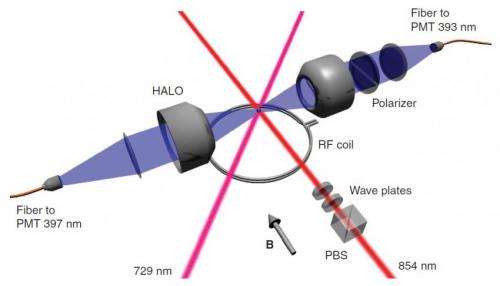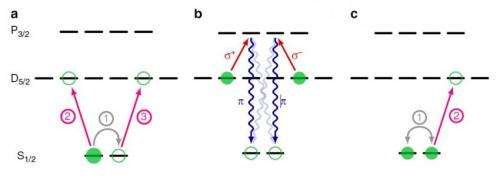November 28, 2014 feature
High-fidelity photon-to-atom quantum state transfer could form backbone of quantum networks

(Phys.org) —In a quantum network, information is stored, processed, and transmitted from one device to another in the form of quantum states. The quantum nature of the network gives it certain advantages over classical networks, such as greater security.
One promising method for implementing a quantum network involves using both atoms and photons for their unique advantages. While atoms are useful as nodes (in the form of quantum memories and processors) due to their long storage times, photons are useful as links (on optical fibers) because they're better at carrying quantum information over large distances.
However, using both atoms and photons requires that quantum states be converted between single atoms and single photons. This in turn requires a high degree of control over the emission and absorption processes in which single atoms act as senders and receivers of single photons. Because it's difficult to achieve complete overlap between the atomic and photonic modes, photon-to-atom state transfer usually suffers from low fidelities of below 10%. This means that more than 90% of the time the state transfer is unsuccessful.
In a new paper published in Nature Communications, a team of researchers led by Jürgen Eschner, Professor at Saarland University in Saarbrucken, Germany, has experimentally demonstrated photon-to-atom quantum state transfer with a fidelity of more than 95%. This drastic improvement marks an important step toward realizing future large-scale quantum networks.
The researchers' protocol consists of transferring the polarization state of a laser photon onto the ground state of a trapped calcium ion. To do this, the researchers prepared the calcium ion in a quantum superposition state, in which it simultaneously occupies two atomic levels. When the ion absorbs a photon emitted by a laser at an 854-nm wavelength, the photon's polarization state gets mapped onto the ion. Upon absorbing the photon, the ion returns to its ground state and emits a single photon at a 393-nm wavelength. Detection of this 393-nm photon signifies a successful photon-to-atom quantum state transfer.

The researchers showed that this method achieves very high fidelities of 95-97% using a variety of atomic states and both linear and circular polarizations. The method also has a relatively high efficiency of 0.438%. The researchers explain that the large fidelity improvement is due in large part to the last step involving the detection of the 393-nm photon.
"We made the achievable state-transfer fidelity independent from the transfer success probability," coauthor Christoph Kurz at Saarland University told Phys.org. "Using protocols from other research groups with no heralding signal, the achievable fidelity can never exceed the success probability (which is typically less than 10%). Since we have such a signal (the detection of a single 393-nm photon), we can discriminate between successful and unsuccessful events and hence continue with quantum information processing every time the transfer was successful."
In the future, the researchers plan to extend the scheme to a pair of entangled photons to achieve photon-to-atom entanglement transfer. In this scenario, two ions located in remote traps would each absorb one of the entangled photons, which originate from a spontaneous parametric down-conversion (SPDC) source. The detection of two 393-nm photons in separate locations would herald the entanglement of the two spatially separated ions. With further research, this kind of ion entanglement can lead to the development of new applications.
"In the future, we plan to combine quantum networks with local quantum information processing," Kurz said. "For this, establishing entanglement between remotely trapped ions is an essential building block."
More information: Christoph Kurz, et al. "Experimental protocol for high-fidelity heralded photon-to-atom quantum state transfer." Nature Communications. DOI: 10.1038/ncomms6527
Journal information: Nature Communications
© 2014 Phys.org


















